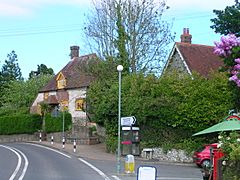Cocking, West Sussex facts for kids
Quick facts for kids Cocking |
|
|---|---|
 Cocking village centre |
|
| Area | 10.16 km2 (3.92 sq mi) |
| Population | 420 2011 Census |
| • Density | 45/km2 (120/sq mi) |
| OS grid reference | SU878176 |
| • London | 47 miles (76 km) NE |
| Civil parish |
|
| District |
|
| Shire county | |
| Region | |
| Country | England |
| Sovereign state | United Kingdom |
| Post town | MIDHURST |
| Postcode district | GU29 |
| Dialling code | 01730 |
| Police | Sussex |
| Fire | West Sussex |
| Ambulance | South East Coast |
| EU Parliament | South East England |
| UK Parliament |
|
| Website | http://www.cocking.org/ |
Cocking is a small village and civil parish (a local government area) located in the Chichester district of West Sussex, England. It's about three miles (5 km) south of the town of Midhurst and sits along the main A286 road that leads to Chichester.
In 2011, the village had a population of 420 people. This means it's a pretty quiet and peaceful place to live!
Contents
A Look Back: Cocking's History
Cocking has a long history, even appearing in the famous Domesday Book from 1086. Back then, it was called Cochinges. The Domesday Book was like a big survey ordered by King William the Conqueror to record everything in England. It showed that Cocking had 32 households, including farmers and workers, five mills, and a church. This tells us it was an active place even a thousand years ago!
Important Buildings and Landmarks
The main Anglican church in Cocking is very old, dating back to the 11th century. For a long time, it didn't have a special name, but in 2007, it was officially named after St. Catherine of Siena. There was also another church, a Congregational Chapel, built in 1806 and rebuilt in 1907. Today, this old chapel is a private home.
In the heart of the village, you can find the old school building. It was built in 1870 and designed by famous architects Richard Carpenter and William Slater. The school has cool Gothic-style windows and doorways. It's made of flint stone with a red-tiled roof. The house where the schoolmaster used to live has a unique chimney with four openings!
Industrial Past of Cocking
To the south of Cocking, you can still see what's left of the Cocking Lime Works. This was a factory that made lime from chalk, and it closed down in 1999. There's also a big chalk pit nearby where they got the raw materials. North of the village, you might find tiny hints of the old Chorley Iron Foundry. This foundry made large metal waterwheels, some of which you can now see at the Weald and Downland Open Air Museum and the Coultershaw Beam Pump.
Many houses in Cocking are very old, some even from the 17th century. This means they are over 300 years old! There used to be a pub called the Richard Cobden in the village, but it closed and became a private house. Richard Cobden was a famous politician who lived nearby. In total, there are 28 buildings in the village that are considered "listed buildings," meaning they are historically important and protected.
Getting Around: Transport in Cocking
Long ago, Cocking had its own railway station. It was part of the railway line that connected Chichester to Midhurst, opening in 1881. However, the railway line closed completely in 1953.
Today, if you want to travel by public transport, you can use the Stagecoach South No. 60 bus route. This bus runs between Midhurst and Chichester, passing right through Cocking on the A286 road.
Cocking Today
Many of the buildings in Cocking belong to the Cowdray Estate. You can often spot these buildings because their outdoor wooden parts are painted a bright yellow!
The village still has one pub, which used to be called The Blue Bell. Now, it's known as The Bluebell Inn and serves as a restaurant with rooms where people can stay overnight.
Cocking is also a popular spot for walkers because it's located right on the South Downs Way. This is a famous long-distance walking path that stretches across the beautiful South Downs National Park.


